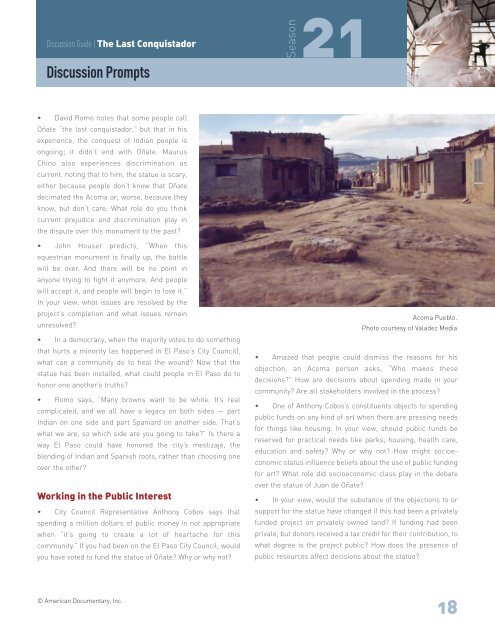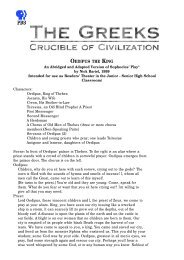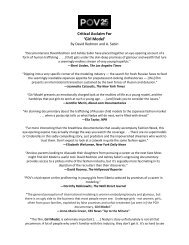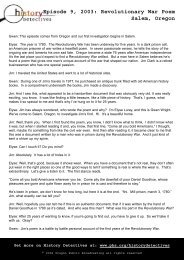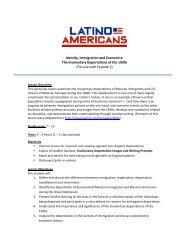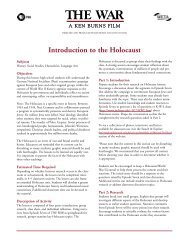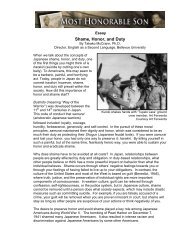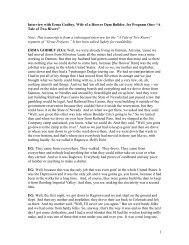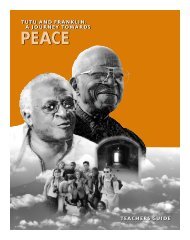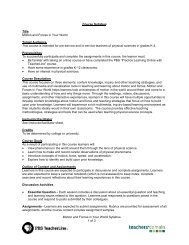DG - The Last Conquistador - PBS
DG - The Last Conquistador - PBS
DG - The Last Conquistador - PBS
Create successful ePaper yourself
Turn your PDF publications into a flip-book with our unique Google optimized e-Paper software.
Discussion Guide | <strong>The</strong> <strong>Last</strong> <strong>Conquistador</strong>Discussion PromptsSeason21• David Romo notes that some people callOñate “the last conquistador,” but that in hisexperience, the conquest of Indian people isongoing; it didn’t end with Oñate. MaurusChino also experiences discrimination ascurrent, noting that to him, the statue is scary,either because people don’t know that Oñatedecimated the Acoma or, worse, because theyknow, but don’t care. What role do you thinkcurrent prejudice and discrimination play inthe dispute over this monument to the past?• John Houser predicts, “When thisequestrian monument is finally up, the battlewill be over. And there will be no point inanyone trying to fight it anymore. And peoplewill accept it, and people will begin to love it.”In your view, what issues are resolved by theproject’s completion and what issues remainunresolved?• In a democracy, when the majority votes to do somethingthat hurts a minority (as happened in El Paso’s City Council),what can a community do to heal the wound? Now that thestatue has been installed, what could people in El Paso do tohonor one another’s truths?• Romo says, “Many browns want to be white. It’s realcomplicated, and we all have a legacy on both sides — partIndian on one side and part Spaniard on another side. That’swhat we are, so which side are you going to take?” Is there away El Paso could have honored the city’s mestizaje, theblending of Indian and Spanish roots, rather than choosing oneover the other?Working in the Public Interest• City Council Representative Anthony Cobos says thatspending a million dollars of public money is not appropriatewhen “it’s going to create a lot of heartache for thiscommunity.” If you had been on the El Paso City Council, wouldyou have voted to fund the statue of Oñate? Why or why not?Acoma Pueblo.Photo courtesy of Valadez Media• Amazed that people could dismiss the reasons for hisobjection, an Acoma person asks, “Who makes thesedecisions?” How are decisions about spending made in yourcommunity? Are all stakeholders involved in the process?• One of Anthony Cobos’s constituents objects to spendingpublic funds on any kind of art when there are pressing needsfor things like housing. In your view, should public funds bereserved for practical needs like parks, housing, health care,education and safety? Why or why not? How might socioeconomicstatus influence beliefs about the use of public fundingfor art? What role did socioeconomic class play in the debateover the statue of Juan de Oñate?• In your view, would the substance of the objections to orsupport for the statue have changed if this had been a privatelyfunded project on privately owned land? If funding had beenprivate, but donors received a tax credit for their contribution, towhat degree is the project public? How does the presence ofpublic resources affect decisions about the statue?© American Documentary, Inc.18


